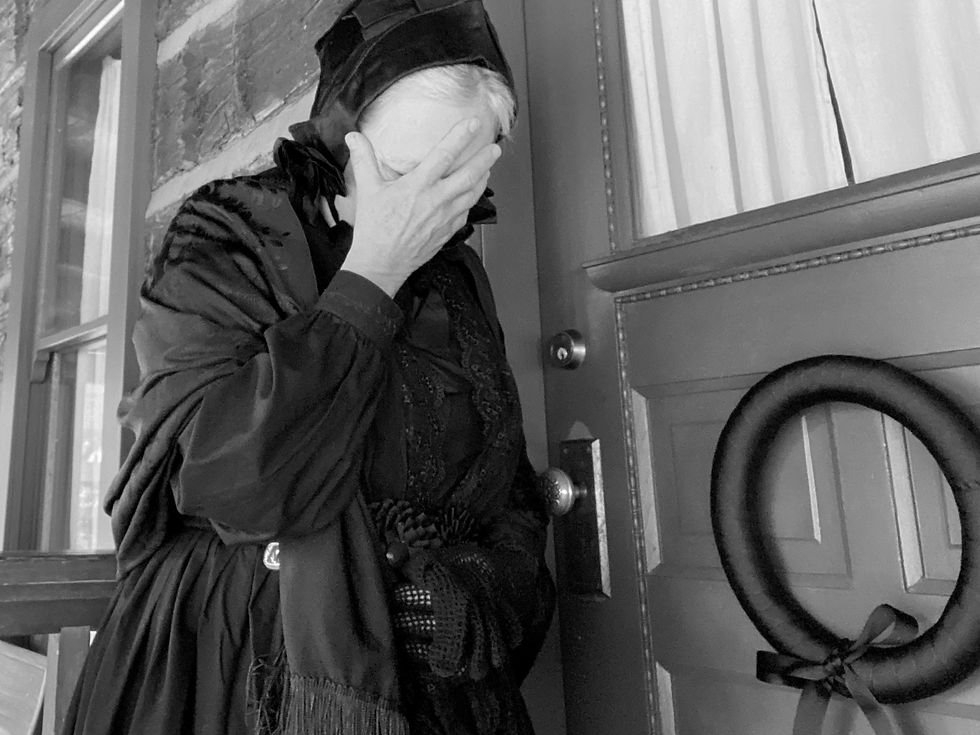Mourning in the 19th Century
- kathleen3001
- Oct 10, 2021
- 3 min read

As a volunteer at our local museum, I participate in the Living History Program.
Yesterday our theme was 19th Century Mourning.
A couple of us have the correct clothes for what was called "full mourning", so we looked plenty sorrowful!
The mourner above is my friend, Jennifer. (Look into the next room, you will see black fabric draped over a mirror.)

This is who we were mourning yesterday. Margaret McCormick. She was the wife of Arizona's second Territorial Governor. She died in childbirth, a few days before her 24th birthday. For such a young woman, her influence on early Arizona was remarkable. Her obituary is very long, and touching.
It begins:
"Died at Prescott, Arizona, on Tuesday, April 30, 1867, at 7p.m., Margaret Griffiths Hunt, daughter of Isaac L. Hunt, Esq., of Rahway, New Jersey, and wife of Hon. Richard C. McCormick, Governor of Arizona. Age 24. This sudden and unexpected death of this most estimable and greatly beloved woman, has cast a gloom over this community which language cannot describe."

This is where Margaret lived from fall of 1865 till she passed away here in April 1867.
Such a short time she was here, to have left such a legacy!
Anyway, on to mourning. We were based in the same building you see above. It is a part of the Sharlot Hall Museum, in fact it is the heart of the museum!
Here is what I wore:

Mourning in the 1800s had two stages: Full (or Deep) Mourning, and Half Mourning. My ensemble is Full Mourning. Full Mourning dress is black - black, black, black. In the 19th century they took care to be sure the fabrics were extra dull, not to reflect light. They used black crepe to accomplish this. Thankfully, this fabric is not available anymore. The fabric called mourning crepe started out as silk, but it was gummed (ick) , and twisted resulting in a fabric that would be dull, but it did not hold up in rain. It sort of melted. Again - ICK. My clothing is a combination of cotton and silk pieces. The shawl I have on was my grandmother's. It works so well for mourning!

We had a casket set up in the parlor. We picked some fall flowers from the museum grounds, and tied them with a thin black velvet ribbon.
In the 19th century, the deceased would be placed in such a room, and watched over continuously by family members or friends, until burial.

The home would typically be decked with black wreaths. Black fabric would cover all mirrors, and all drapes would be drawn. The clock would be stopped at the time of death. Some people immediately opened windows, to allow the spirit of the deceased to exit.

In this photo I am wearing a "widows bonnet" or 'widow's cap" - these were much more common in England, than here. A woman grieving a husband would continue to wear this garb for a year in the USA (longer in England!)
After the first year, Half Mourning wear would be adopted. During Half Mourning, a woman could add in more jewelry, wear a silk dress rather than the icky crepe (black of course), and maybe even have some white cuffs and collar, or purple accents to her dress! This lasted - you guessed it - another year.
The rules for men were so much more lenient. Men only adopted the wearing of a black armband, and maybe a black hat band, and for a fraction of the time required for women to wear all black. Widowers were also allowed to return to society functions much sooner than women. Women in full mourning had to stay away from all weddings, theatres, and social gatherings.




On to a less mournful note:
Happy Fall, Happy October, and Happy Halloween!


Me in mourning - BOO!
































Comments